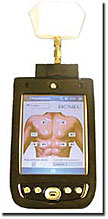- Number 289 |
- June 22, 2009
Pneumothorax detector could save lives

The noninvasive
pneumothorax
detector connects
to a standard
personal digital
assistant. A
graphical user
interface guides
diagnosis.
Researchers at DOE's Lawrence Livermore National Laboratory have developed a new medical diagnostic instrument to detect pneumothorax, a condition caused by air trapped in the space between the wall of the chest cavity and the lung.
The technology has been licensed to ElectroSonics Medical Inc. (EMI), a Cleveland, Ohio-based company. Collaborating under a work-for-
others contract, two Cooperative Research and Development Agreements (CRADAs) and two commercial licenses, the Lab and EMI have developed a prototype based on a handheld personal digital assistant with a graphical user interface.
Known as the “Noninvasive Pneumothorax Detector,” the handheld instrument uses ultra-wideband radar technology pioneered in the 1990s by LLNL researchers who had worked on the Nova laser.
The medical condition of pneumothorax often results in reduced lung capacity or a collapsed lung. If it is not properly diagnosed and promptly treated, pneumothorax can cause death within minutes.
Current methods to definitively diagnose pneumothorax involve the use of chest X-rays or computed tomography (CT) scans. In some cases, however, there may not be sufficient time to use X-rays or CT scans, or the patient may be in a remote location where these methods aren't available.
Medical response teams in the field use the less conclusive method of looking for respiratory distress, listening for unusual sounds in the lungs and feeling for broken ribs.
A portable, lightweight, battery-operated device, the noninvasive pneumothorax detector can accurately diagnose pneumothorax in real time, and can be used in a hospital setting and in the field.
Submitted by DOE's Lawrence Livermore National Laboratory
